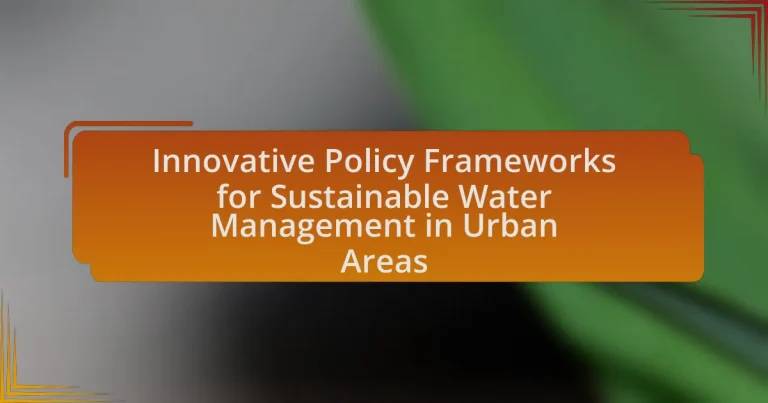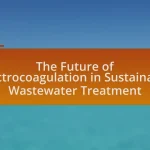Innovative policy frameworks for sustainable water management in urban areas encompass integrated water resource management (IWRM), water-sensitive urban design (WSUD), and smart water technologies. These frameworks address urban water challenges such as scarcity, pollution, and flooding by promoting stakeholder engagement and the adoption of innovative technologies. Key components include adaptive governance, data analytics, and collaboration among various stakeholders, which enhance the effectiveness of water management policies. Successful case studies, such as those from Singapore and Melbourne, demonstrate the positive impact of these frameworks on water conservation, quality, and urban resilience.
What are Innovative Policy Frameworks for Sustainable Water Management in Urban Areas?
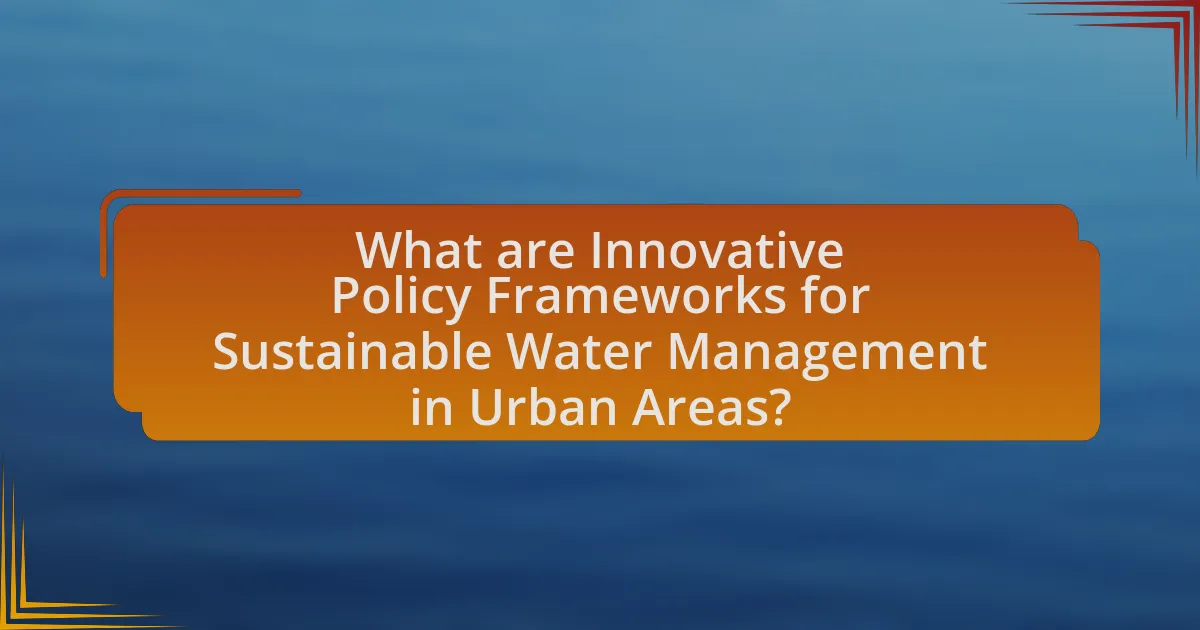
Innovative policy frameworks for sustainable water management in urban areas include integrated water resource management (IWRM), water-sensitive urban design (WSUD), and the implementation of smart water technologies. IWRM promotes the coordinated development and management of water, land, and related resources, ensuring sustainability and efficiency. WSUD focuses on designing urban environments that manage the quantity and quality of stormwater, enhancing biodiversity and reducing urban heat. Smart water technologies utilize data analytics and IoT to optimize water distribution and usage, leading to reduced waste and improved service delivery. These frameworks are supported by evidence from various case studies, such as the successful implementation of IWRM in Singapore, which has led to a significant increase in water reuse and conservation efforts.
How do these frameworks address urban water challenges?
These frameworks address urban water challenges by promoting integrated water resource management, enhancing stakeholder engagement, and implementing innovative technologies. Integrated water resource management ensures that water supply, quality, and ecosystem health are considered collectively, leading to more sustainable urban water systems. Stakeholder engagement fosters collaboration among government, private sector, and community members, which is essential for identifying local needs and solutions. Additionally, the adoption of innovative technologies, such as smart water management systems and green infrastructure, helps cities optimize water use, reduce waste, and improve resilience to climate change impacts. For instance, cities implementing these frameworks have reported reductions in water loss by up to 30% through better monitoring and management practices.
What specific urban water challenges do these frameworks target?
These frameworks target specific urban water challenges such as water scarcity, pollution, flooding, and inefficient water distribution. Water scarcity is addressed through policies promoting conservation and alternative sources, while pollution control measures focus on reducing contaminants in urban water bodies. Flooding challenges are tackled by implementing sustainable drainage systems and green infrastructure. Additionally, frameworks aim to enhance the efficiency of water distribution networks to minimize losses and ensure equitable access. These targeted challenges are critical for achieving sustainable urban water management.
How do these frameworks integrate with existing urban planning policies?
Innovative policy frameworks for sustainable water management integrate with existing urban planning policies by aligning water management objectives with land use, infrastructure development, and environmental sustainability goals. These frameworks often incorporate principles such as integrated water resource management (IWRM) and green infrastructure, which are designed to complement urban planning efforts. For instance, cities implementing IWRM can enhance stormwater management through the use of permeable surfaces and green roofs, thereby reducing runoff and improving water quality. This integration is supported by case studies, such as the City of Melbourne’s Water Sensitive Urban Design policy, which demonstrates how urban planning can effectively incorporate sustainable water practices to achieve both water conservation and urban resilience.
Why are these frameworks essential for urban sustainability?
Innovative policy frameworks are essential for urban sustainability because they provide structured approaches to manage resources effectively and promote environmental resilience. These frameworks facilitate the integration of sustainable practices in urban planning, ensuring that water management aligns with ecological, social, and economic goals. For instance, cities implementing integrated water resource management (IWRM) frameworks have reported improved water quality and reduced flooding risks, demonstrating their effectiveness in addressing urban challenges.
What role does water management play in urban sustainability?
Water management is crucial for urban sustainability as it ensures the efficient use and conservation of water resources, which are vital for supporting urban populations and ecosystems. Effective water management practices, such as rainwater harvesting, wastewater recycling, and sustainable drainage systems, help mitigate water scarcity, reduce flooding risks, and enhance water quality. According to the United Nations, urban areas are expected to house 68% of the global population by 2050, making sustainable water management essential for maintaining public health and environmental integrity in densely populated regions.
How do these frameworks contribute to environmental protection?
Innovative policy frameworks for sustainable water management in urban areas contribute to environmental protection by promoting efficient water use, reducing pollution, and enhancing ecosystem resilience. These frameworks implement regulations and incentives that encourage the adoption of green infrastructure, such as rain gardens and permeable pavements, which help manage stormwater runoff and improve water quality. For instance, cities that have adopted such frameworks have reported a significant decrease in urban flooding and waterborne pollutants, demonstrating their effectiveness in safeguarding aquatic ecosystems.
What are the key components of Innovative Policy Frameworks for Sustainable Water Management?
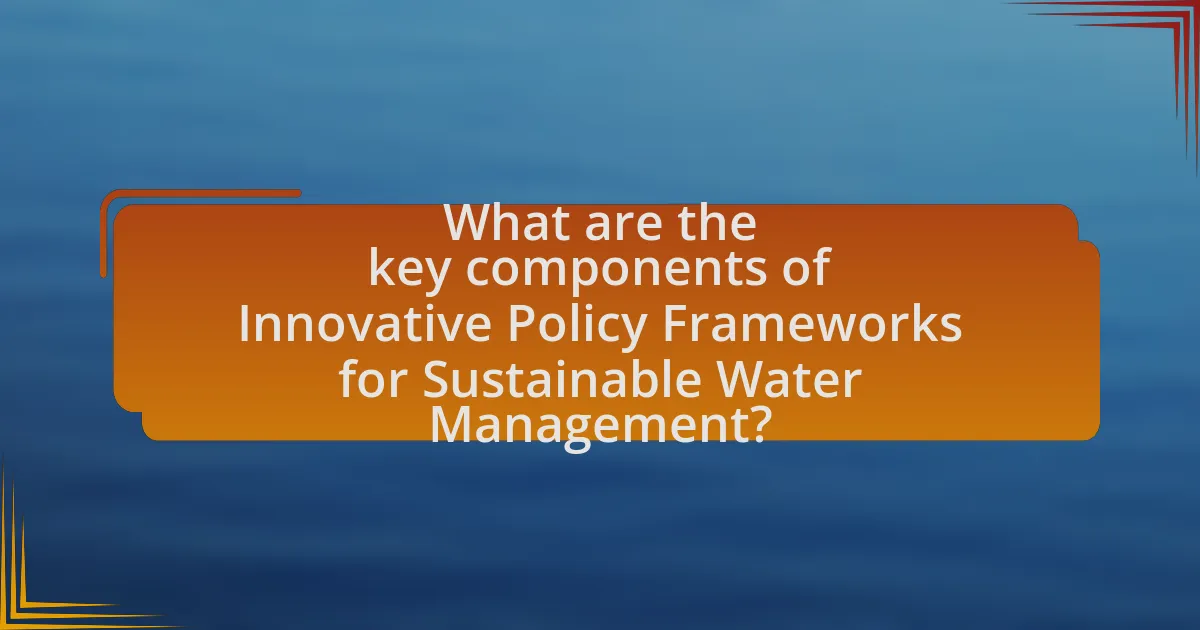
The key components of Innovative Policy Frameworks for Sustainable Water Management include integrated water resource management, stakeholder engagement, adaptive governance, and the incorporation of technology and data analytics. Integrated water resource management ensures that all aspects of the water cycle are considered, promoting a holistic approach to water management. Stakeholder engagement involves collaboration among government, communities, and private sectors, fostering shared responsibility and local knowledge. Adaptive governance allows for flexibility and responsiveness to changing environmental conditions and societal needs. The incorporation of technology and data analytics enhances decision-making processes by providing real-time information and predictive modeling, which supports efficient resource allocation and management. These components collectively contribute to sustainable water management practices in urban areas.
How do stakeholder engagement and collaboration influence these frameworks?
Stakeholder engagement and collaboration significantly enhance innovative policy frameworks for sustainable water management in urban areas by ensuring diverse perspectives and expertise are integrated into decision-making processes. This inclusive approach leads to more effective and contextually relevant policies, as evidenced by case studies where stakeholder involvement has resulted in improved water quality and resource management outcomes. For instance, the collaboration between local governments, community organizations, and businesses in cities like Melbourne has led to the successful implementation of integrated water management strategies, demonstrating that stakeholder engagement fosters accountability and shared responsibility, ultimately driving sustainable practices.
What types of stakeholders are involved in the development of these frameworks?
The types of stakeholders involved in the development of innovative policy frameworks for sustainable water management in urban areas include government agencies, local municipalities, non-governmental organizations (NGOs), community groups, private sector companies, and academic institutions. Government agencies and local municipalities are responsible for regulatory frameworks and implementation, while NGOs and community groups advocate for public interests and environmental sustainability. Private sector companies contribute through technology and infrastructure investments, and academic institutions provide research and data to inform policy decisions. This multi-stakeholder approach ensures that diverse perspectives and expertise are integrated into the framework development process, enhancing its effectiveness and sustainability.
How can collaboration enhance the effectiveness of water management policies?
Collaboration enhances the effectiveness of water management policies by fostering shared knowledge, resources, and stakeholder engagement. When various stakeholders, including government agencies, local communities, and private sectors, work together, they can identify common goals and develop integrated strategies that address the complexities of water management. For instance, collaborative efforts can lead to the pooling of financial resources, which enables the implementation of larger and more impactful projects. Additionally, studies have shown that collaborative governance models, such as those implemented in the European Union’s Water Framework Directive, result in improved water quality and sustainable usage by incorporating diverse perspectives and expertise. This collective approach not only increases accountability but also ensures that policies are more responsive to local needs and conditions, ultimately leading to more effective water management outcomes.
What innovative technologies are incorporated into these frameworks?
Innovative technologies incorporated into frameworks for sustainable water management in urban areas include smart water metering, real-time data analytics, and advanced filtration systems. Smart water metering utilizes IoT devices to monitor water usage and detect leaks, enhancing efficiency and conservation. Real-time data analytics processes large datasets to optimize water distribution and predict demand, thereby improving resource management. Advanced filtration systems, such as membrane bioreactors, provide effective treatment of wastewater, enabling its reuse and reducing environmental impact. These technologies collectively contribute to more sustainable urban water management practices.
How do smart water management systems improve efficiency?
Smart water management systems improve efficiency by utilizing advanced technologies such as IoT sensors, data analytics, and automated controls to optimize water distribution and usage. These systems enable real-time monitoring of water flow, pressure, and quality, allowing for immediate detection of leaks and inefficiencies. For instance, a study by the International Water Association found that implementing smart water management can reduce water losses by up to 30%, significantly enhancing resource conservation and operational efficiency. Additionally, predictive analytics can forecast demand patterns, leading to better resource allocation and reduced energy consumption in water treatment and distribution processes.
What role do data analytics and modeling play in these frameworks?
Data analytics and modeling are essential components of innovative policy frameworks for sustainable water management in urban areas. They enable the collection, analysis, and interpretation of large datasets related to water usage, quality, and availability, which inform decision-making processes. For instance, predictive modeling can forecast water demand and supply scenarios, allowing policymakers to develop strategies that optimize resource allocation and mitigate potential shortages. Furthermore, data analytics can identify trends and patterns in water consumption, helping to implement targeted conservation measures. The integration of these tools enhances the effectiveness of policies by providing evidence-based insights that support sustainable practices and improve overall water management outcomes.
What are the best practices for implementing Innovative Policy Frameworks in urban areas?
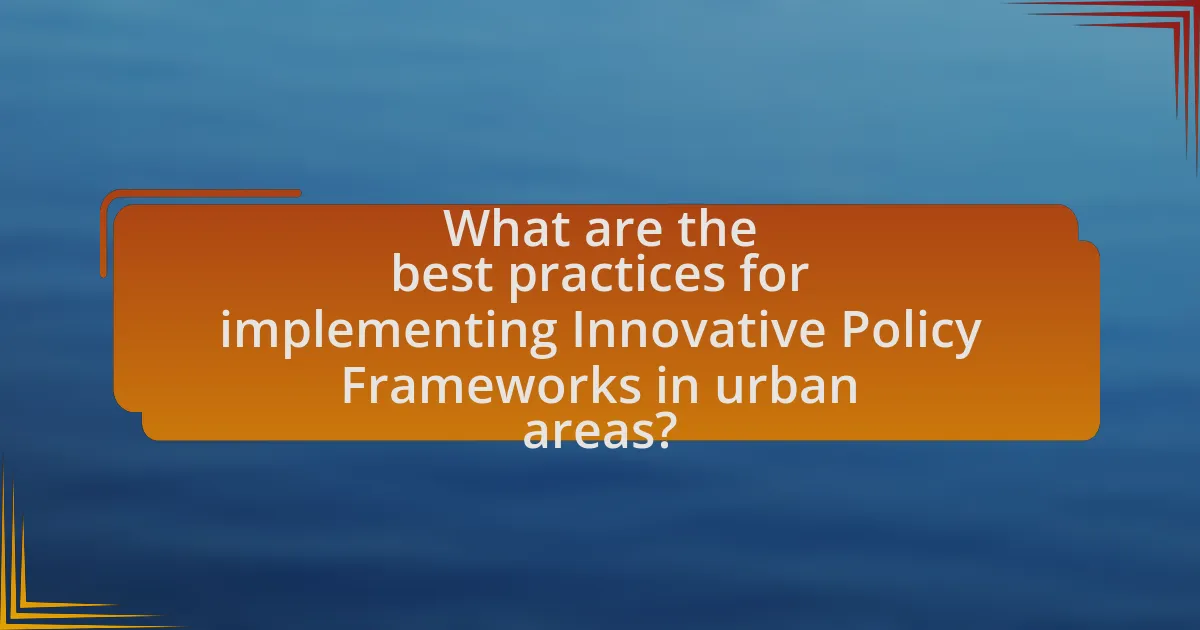
The best practices for implementing Innovative Policy Frameworks in urban areas include stakeholder engagement, data-driven decision-making, and adaptive management. Stakeholder engagement ensures that the voices of local communities, businesses, and government entities are considered, fostering collaboration and support for policies. Data-driven decision-making involves utilizing accurate and relevant data to inform policy choices, which enhances transparency and accountability. Adaptive management allows for policies to be adjusted based on real-time feedback and changing conditions, ensuring that they remain effective and relevant. These practices are supported by successful case studies, such as the implementation of integrated water resource management in cities like Singapore, which has led to improved water sustainability and resilience.
How can cities effectively adopt these frameworks?
Cities can effectively adopt innovative policy frameworks for sustainable water management by implementing integrated planning processes that involve stakeholders at all levels. This approach ensures that diverse perspectives are considered, leading to more comprehensive and effective strategies. For instance, cities like Singapore have successfully integrated water management into urban planning, resulting in a 50% reduction in water consumption per capita since the 2000s. Additionally, cities can leverage technology and data analytics to monitor water usage and identify areas for improvement, as demonstrated by Barcelona’s smart water management system, which has reduced leaks by 25%. Engaging the community through education and participatory initiatives further enhances the adoption of these frameworks, as seen in Melbourne’s water conservation campaigns that have significantly increased public awareness and participation.
What steps should urban planners take to ensure successful implementation?
Urban planners should engage in comprehensive stakeholder collaboration to ensure successful implementation of innovative policy frameworks for sustainable water management in urban areas. This involves identifying and involving key stakeholders, such as local communities, government agencies, and environmental organizations, to gather diverse perspectives and foster a sense of ownership.
Additionally, urban planners must conduct thorough data analysis and feasibility studies to inform decision-making and tailor policies to specific local contexts. Evidence from successful urban water management initiatives, such as the Green Infrastructure program in Philadelphia, demonstrates that integrating green spaces can effectively manage stormwater while enhancing urban aesthetics and biodiversity.
Furthermore, establishing clear metrics for success and ongoing monitoring mechanisms is essential to evaluate the effectiveness of implemented policies. Research indicates that cities with robust monitoring frameworks, like Melbourne, have achieved significant improvements in water quality and resource efficiency. By following these steps, urban planners can enhance the likelihood of successful implementation of sustainable water management policies.
How can cities measure the success of these frameworks?
Cities can measure the success of innovative policy frameworks for sustainable water management by evaluating key performance indicators (KPIs) such as water quality, water conservation rates, and community engagement levels. For instance, tracking improvements in water quality can be done through regular testing of local water sources, which provides quantifiable data on the effectiveness of implemented policies. Additionally, measuring water conservation rates can involve analyzing changes in water usage statistics before and after policy implementation, demonstrating the frameworks’ impact on reducing consumption. Community engagement can be assessed through surveys and participation rates in water management programs, indicating public support and awareness of sustainability efforts. These metrics collectively provide a comprehensive view of the frameworks’ effectiveness in achieving sustainable water management goals.
What challenges might cities face during implementation?
Cities may face several challenges during the implementation of innovative policy frameworks for sustainable water management. These challenges include insufficient funding, which can hinder the development and maintenance of necessary infrastructure, as evidenced by a 2021 report from the American Society of Civil Engineers indicating that U.S. cities require over $1 trillion to upgrade water systems. Additionally, bureaucratic hurdles can slow down the decision-making process, leading to delays in project execution. Resistance from stakeholders, including local communities and businesses, can also pose significant obstacles, as seen in various case studies where public opposition has stalled initiatives. Lastly, a lack of technical expertise and data can impede effective planning and execution, as highlighted by the United Nations’ 2020 World Water Development Report, which emphasizes the need for skilled personnel in water management.
How can cities overcome resistance to change in water management practices?
Cities can overcome resistance to change in water management practices by engaging stakeholders through education and participatory decision-making processes. By involving community members, businesses, and local organizations in discussions about water management, cities can address concerns and build trust. Research indicates that cities that implement inclusive strategies, such as public forums and workshops, see a higher acceptance of new practices. For example, the City of Melbourne successfully adopted new water conservation measures by actively involving residents in the planning process, resulting in a 20% reduction in water usage.
What financial considerations should be taken into account?
Financial considerations for sustainable water management in urban areas include the assessment of funding sources, cost-benefit analysis, and long-term financial sustainability. Funding sources may involve government grants, public-private partnerships, and community investments, which are essential for initiating and maintaining water management projects. Cost-benefit analysis helps in evaluating the economic viability of proposed initiatives by comparing the expected benefits, such as improved water quality and reduced flooding, against the costs incurred. Long-term financial sustainability ensures that water management systems can be maintained over time without excessive reliance on external funding, which is critical for ongoing operational effectiveness.
What practical tips can urban areas follow for sustainable water management?
Urban areas can implement rainwater harvesting systems to enhance sustainable water management. This practice allows cities to collect and store rainwater for non-potable uses, reducing reliance on traditional water sources. According to the United Nations, rainwater harvesting can decrease urban runoff by up to 50%, mitigating flooding and improving water quality. Additionally, urban areas should promote the use of permeable surfaces in construction to facilitate groundwater recharge, which can help maintain local aquifers. Research indicates that permeable pavements can reduce surface runoff by 80%, contributing to better water management. Furthermore, implementing water-efficient appliances and fixtures in residential and commercial buildings can significantly lower water consumption; studies show that such measures can reduce water use by 30% or more. Lastly, public education campaigns about water conservation can foster community engagement and awareness, leading to more sustainable practices among residents.
